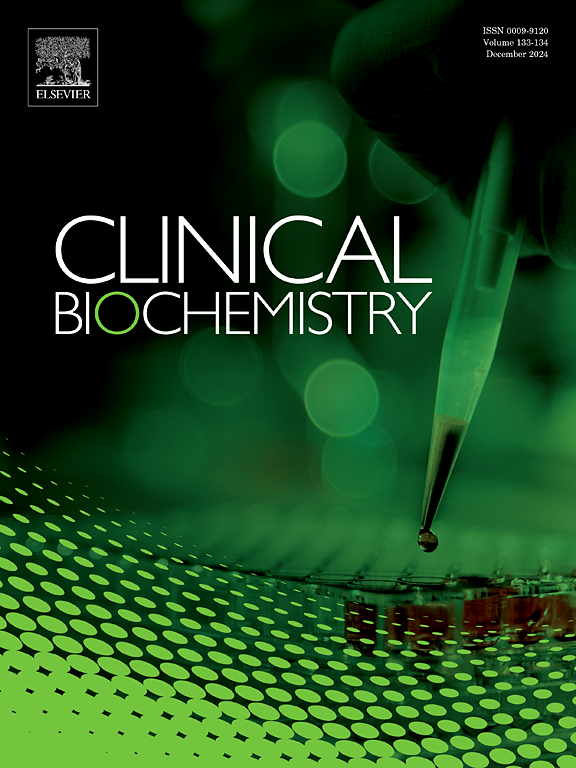重新评估铁蛋白阈值诊断缺铁。
IF 2.1
3区 医学
Q2 MEDICAL LABORATORY TECHNOLOGY
引用次数: 0
摘要
背景:缺铁(ID)和缺铁性贫血(IDA)是一种普遍且可治疗的疾病,对女性的影响尤为严重。血清铁蛋白是ID和IDA最敏感的生物标志物,但其在临床决策中的应用受到性别特异性参考区间(RIs)的限制,RIs通常低于循证推荐值。在RI研究中纳入无症状的缺铁个体可能是不适当的铁蛋白阈值的原因,一个专家共识小组提出了30 µg/L的较低临界值以提高灵敏度。在这项研究中,我们评估了铁蛋白RIs在我们的患者群体中诊断ID和IDA的作用。方法:从实验室信息系统(LIS)中提取患者资料,包括年龄、出生性别、血红蛋白和铁标志物。根据铁、转铁蛋白饱和度和血红蛋白的测量结果,将患者分为补铁(IR)、补铁(ID)或补铁(IDA)组。IR组的铁蛋白值用于生成新的参考范围,并绘制受试者操作特征(ROC)曲线,以确定诊断ID和IDA的最佳铁蛋白截止值。结果:IR组产生的铁蛋白RIs在女性和男性中的下限分别为16.9 µg/L和30 µg/L。ROC曲线的约登指数分析确定了女性和男性ID的最佳截止值分别为45 µg/L和70 µg/L,将女性组的诊断敏感性提高了44 %。结论:这些发现与增加铁蛋白临界值的建议是一致的,并表明临床实验室需要重新检查铁蛋白RIs,特别是在女性患者人群中的ID诊断中。本文章由计算机程序翻译,如有差异,请以英文原文为准。
Re-evaluating ferritin thresholds to diagnose iron deficiency
Background
Iron deficiency (ID) and iron deficiency anemia (IDA) are prevalent and treatable conditions which disproportionately affect women. Serum ferritin is the most sensitive biomarker for ID and IDA, but its utility in clinical decision making is limited by sex-specific reference intervals (RIs) that are frequently lower than evidence-based recommendations. The inclusion of asymptomatic, iron-depleted individuals in RI studies likely accounts for inappropriate ferritin thresholds, and a lower cutoff of 30 µg/L has been proposed by an expert consensus panel to improve sensitivity. In this study, we assessed ferritin RIs for diagnosing ID and IDA in our patient population.
Methods
Patient data, including age, sex assigned at birth, hemoglobin, and iron markers, were extracted from the laboratory information system (LIS). Patients were stratified into iron replete (IR), ID, or IDA groups based on measurements for iron, transferrin saturation, and hemoglobin. Ferritin values from the IR group were used to generate new reference ranges and receiver operator characteristic (ROC) curves were plotted to define optimal ferritin cutoffs for diagnosis of ID and IDA.
Results
Ferritin RIs generated from the IR group had lower limit cutoffs of 16.9 µg/L and 30 µg/L for females and males, respectively. Youden Index analysis of ROC curves identified optimal cutoffs of 45 µg/L and 70 µg/L for ID in females and males, respectively, improving diagnostic sensitivity by 44 % in the female group.
Conclusions
These findings are consistent with recommendations for increasing ferritin cutoffs and demonstrate the need for clinical laboratories to re-examine ferritin RIs, particularly for ID diagnosis in the female patient population.
求助全文
通过发布文献求助,成功后即可免费获取论文全文。
去求助
来源期刊

Clinical biochemistry
医学-医学实验技术
CiteScore
5.10
自引率
0.00%
发文量
151
审稿时长
25 days
期刊介绍:
Clinical Biochemistry publishes articles relating to clinical chemistry, molecular biology and genetics, therapeutic drug monitoring and toxicology, laboratory immunology and laboratory medicine in general, with the focus on analytical and clinical investigation of laboratory tests in humans used for diagnosis, prognosis, treatment and therapy, and monitoring of disease.
 求助内容:
求助内容: 应助结果提醒方式:
应助结果提醒方式:


